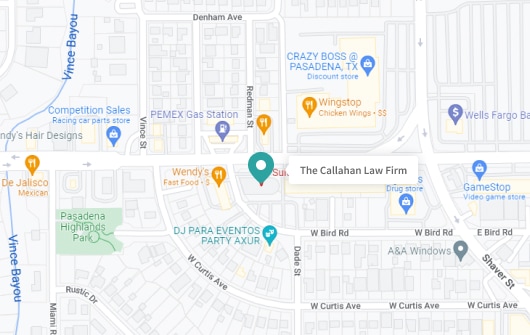Houston Crane Accident Attorneys

Cranes are essential machinery used in many industries, from construction to oil and gas. Unfortunately, crane accidents are far too common and often result in serious injuries or even death. Operating a crane is a complex job that requires extensive knowledge and skill. While there are currently no laws in Texas that require a state issued license, OSHA requires that all crane operators be trained in a nationally accredited program.
If you were injured in a crane accident in Houston, it is crucial to have experienced legal representation. At The Callahan Law Firm, our trusted Houston crane accident lawyers have the resources and knowledge to effectively guide you through the legal process, determine who is liable for your injuries, and aggressively pursue the maximum compensation you deserve.
What former Clients say:
When my husband died at work in a crane accident, I wanted answers as to what happened and why. My lawyers at The Callahan Law Firm worked very hard to investigate the incident and uncover the evidence to hold the company accountable. I am so grateful for the work they did to help me get some answers and make the company take responsibility for their mistakes.
Brenda R.
Contact us today for a free case review.
Why You Need Our Houston Crane Accident Attorneys
If you’ve been injured in a crane accident, working with an experienced Houston crane accident attorney is the best option for seeking the money you need to cover your losses. The Callahan Law Firm is dedicated to holding negligent parties accountable and helping injured victims pursue the justice they deserve.
Our legal team has successfully handled numerous complex crane accident cases, and we are ready to work tirelessly to seek the maximum compensation available to you. We understand how devastating a crane accident can be and provide personalized legal guidance throughout the process to give you peace of mind.
Our Houston construction injury lawyers will thoroughly investigate the accident that injured you and review all applicable laws to aggressively advocate for your rights. Founding attorney Michael S. Callahan is a former mechanical engineer and Board Certified in Personal Injury Trial Law. Those qualifications give him unique insights into cases involving injuries from complex machinery such as cranes.
Main Risks Associated with Using Cranes
Working with cranes can be dangerous due to the high risk of injury from dropped loads, swinging loads, crane tip-overs, structural collapse, and other failures.
As with any piece of heavy machinery, a malfunctioning or negligently operated crane can severely injure the operator and bystanders and even cause death. Cranes can topple buildings, knock down power lines, damage other structures, damage vehicles, and harm people in their paths.
Primary Reasons Crane Accidents Happen in Houston
Cranes are powerful machines that lift and move heavy loads, making them essential in many industries. While cranes are very useful for moving materials where they need to be, these tools can be hazardous if misused or improperly constructed and maintained.
OSHA estimates that 80% of all crane accidents and failures result from exceeding the rated capacity of the crane. Overloading can cause significant damage to the crane, decreasing its structural integrity and often leading to complete failure. Once these occur, crane operators and nearby personnel can be injured by falling or failing parts.
Overloading may occur in several different ways:
- Handling a load heavier than the crane’s capacity
- Swinging, dragging, or suddenly dropping a load
- Side-loading a boom (Any time the load’s center of gravity is not directly under the crane.)
Some of the other common reasons crane accidents happen include the following:
- Carelessness – Operators must use extreme caution when handling cranes and remain focused. Even a minor mistake can lead to severe injury or death.
- Dropped loads – Dropped loads from cranes can cause immense damage, including loss of life. Operators must follow all safety precautions to ensure that loads are secured.
- Contact with overhead powerlines – Cranes that come into contact with overhead powerlines can cause severe injury and death from electrocution. Operators must be aware of their surroundings to avoid such contact.
- Crane collapses – The weight of the crane, its load, and its components can all contribute to a collapse if they are not correctly maintained or used.
- Inadequate training and improper assembly – Cranes can become hazardous tools without proper operator training and safe crane assembly.
- Mechanical failure – Improperly maintained cranes are at a higher risk of mechanical failure. That can lead to tipping or other dangerous malfunctions that could put workers and bystanders at risk.
What Are the Most Common Injuries in Crane Accidents?
The operation of cranes can be dangerous if proper safety precautions are not taken. Common injuries from crane accidents include:
- Broken bones
- Traumatic brain injuries (TBIs)
- Spinal cord injuries
- Amputation
- Electrocution
- Crush injuries
- Soft tissue injuries
- Internal injuries
Who Is Liable for Crane Accidents in Houston?
Crane accidents can be devastating, and in most cases, they are entirely preventable. If a crane accident happens, our experienced attorneys can help you identify who is responsible and build a solid case to hold them liable for your injuries and related losses. Depending on the circumstances, multiple parties could be liable for a crane accident in Houston, including the following examples:
- The injured person’s employer
- The crane operator
- The company responsible for maintenance of the crane
- The general contractor on a job
- A subcontractor
- The company that manufactured the crane or its faulty parts
How to Prevent Crane Accidents
Cranes are essential to many industries but can be dangerous when improperly set up, maintained, and operated. Here are some tips for avoiding crane accidents:
- Ensure all crane operators are adequately trained and licensed through an OSHA-accepted program.
- Regularly inspect and maintain the crane to ensure its safety.
- Follow all applicable OSHA crane regulations and safety protocols.
- Confirm that the crane operator is aware of their surroundings, including other workers and any potential hazards.
- Double-check the stability of the ground or surface before setting up the crane.
- Keep all crane components in good condition and repair any worn parts immediately.
- Place warning signs around the area when operating a crane.
- Follow local laws and regulations related to crane safety.
- Plan for emergencies, such as power outages or mechanical problems with the crane.
- Always operate the crane according to the manufacturer’s instructions.
Texas Crane Accident Statistics
Data show that crane accidents in Texas are more prevalent than in other states. According to the Bureau of Labor Statistics (BLS), Texas had the most fatal occupational injuries due to cranes in the United States over a recent six-year period. There were 50 fatal injuries involving cranes in Texas during that time – more than triple the number of fatal crane injuries in California and Florida, which tied for second place at 16 injuries.
Nationwide, over half of all deadly crane injuries involve a worker being hit by an object or equipment, according to the BLS.
Over six years, 43 percent of fatal crane injuries at work in the United States happened in the private construction industry, while approximately a quarter of crane deaths happened in the manufacturing industry.
Contact Our Houston Crane Accident Lawyers Today
If you suffered injuries in a crane accident in Houston, the experienced construction accident attorneys at The Callahan Law Firm are ready to help. We have a deep understanding of state and federal regulations for crane safety and are ready to aggressively advocate for your rights. We understand these accidents can have life-altering consequences, so we work hard to help you pursue the full compensation you need.
Contact us today to learn how we can help you during a free legal case review.












